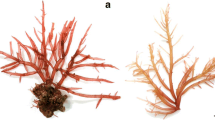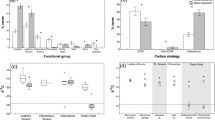Abstract
In situ measurements of seagrass photosynthesis in relation to inorganic carbon (Ci) availability, increased pH and an inhibitor of extracellular carbonic anhydrase were made using an underwater pulse amplitude modulated (PAM) fluorometer. By combining the instrument with a specially designed Perspex chamber, we were able to alter the water surrounding a leaf without removing it from the growing plant. Responses to Ci within the chamber showed that subtidal plants of the seagrasses Cymodocea serrulata and Halophila ovalis had photosynthetic rates that were limited by the ambient Ci concentration depending on the irradiance that was available during short-term photosynthesis–irradiance trials. Relative electron transport rates (RETRs) at light saturation (up to 500 μ mol photons m−2 s−1) increased by 66–100% when the Ci concentration was increased from ca. 2.2 to 6.2 mM. On the other hand, intertidal plants of the same species exhibited a much lesser limitation of photosynthesis by Ci at any irradiance (up to 1500 μ mol photons m−2 s−1). Both species were able to use HCO− 3 efficiently, and there was stronger evidence for direct uptake of HCO− 3 rather than extracellular dehydration of HCO− 3 to CO2 prior to Ci uptake. Subtidally, H. ovalis and C. serrulata grew to 10 and 12 m, respectively, where ambient irradiances were approximately 16 and 11% of those at the surface. Maximum RETRs (at light saturation) were lower for these deep-growing plants than for the intertidally growing ones. For both species, the onset of light saturation of photosynthesis (E k) occurred at approximately 100 μ mol photons m−2 s−1 for the deep water populations, which was four and two times lower than for the shallow populations of C. serrulata and H. ovalis, respectively. This, and the differences in maximal photosynthetic rates (RETR max), reflects an acclimation of the deep-growing populations to the lower light environment. The results presented here show that photosynthesis, as measured in situ, was limited by the availability of Ci for the deeper growing plants in Zanzibar, while the intertidally growing plants photosynthesised at close to Ci saturation. The latter result is contrary to previous conclusions regarding Ci limitations for these intertidal plants, and, in general, our findings highlight the need for performing similar experiments in situ rather than under laboratory conditions.
Similar content being viewed by others
Author information
Authors and Affiliations
Additional information
Received: 4 April 2000 / Accepted: 31 August 2000
Rights and permissions
About this article
Cite this article
Schwarz, AM., Björk, M., Buluda, T. et al. Photosynthetic utilisation of carbon and light by two tropical seagrass species as measured in situ. Marine Biology 137, 755–761 (2000). https://doi.org/10.1007/s002270000433
Issue Date:
DOI: https://doi.org/10.1007/s002270000433




